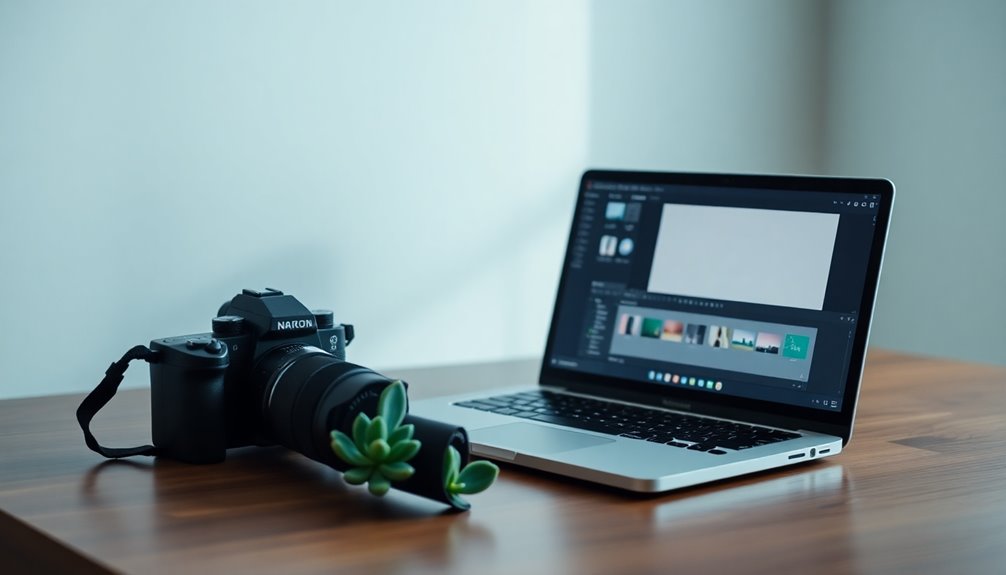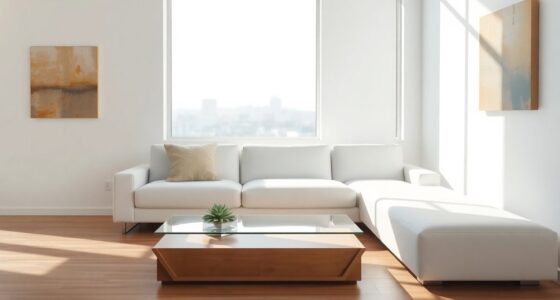Minimalist photo editing is all about simplicity and clarity. You want to let essential elements shine while cutting out distractions. Start with basic tools like Adobe Lightroom for easy adjustments or Photoshop for advanced editing. Focus on exposure, negative space, and muted colors to enhance the overall aesthetic. Maintain composition consistency for a recognizable style. By honing your skills, you'll create timeless images that resonate. If you keep exploring, you'll uncover even more techniques to elevate your work.
Key Takeaways
- Focus on simplicity by emphasizing essential elements in your images while reducing distractions through careful composition and negative space utilization.
- Utilize editing tools like Adobe Lightroom and Photoshop for basic adjustments and advanced features, ensuring a user-friendly experience.
- Adjust exposure, desaturate colors, and apply subtle sharpening techniques to create a clean aesthetic that enhances viewer engagement.
- Maintain a consistent color palette and composition style to develop a recognizable minimalist photography approach that resonates with your audience.
- Find inspiration from minimalist artists and experiment with geometric shapes, subtle color palettes, and ambient lighting to strengthen your visual storytelling.
Understanding Minimalist Photo Editing

When you plunge into minimalist photo editing, you'll quickly notice its focus on simplicity and clarity. This approach emphasizes essential elements in an image while reducing distractions, allowing the main subject to shine.
You'll make minimal adjustments, like refining exposure and utilizing negative space, to create a clean, modern aesthetic. By desaturating colors and sharpening focal points, you enhance viewer engagement, drawing attention where it matters most.
Make subtle adjustments to exposure and negative space for a modern aesthetic that captivates and engages viewers.
The goal is to evoke a timeless look that resonates with your audience. Minimalist editing not only simplifies the process but also amplifies the impact of each image, making every detail count. Embracing this style can be akin to utilizing the subconscious power of your creative instincts, leading to more impactful storytelling in your photos.
Embrace this style, and you'll transform your photos into compelling visual narratives.
Essential Tools for Minimalist Editing
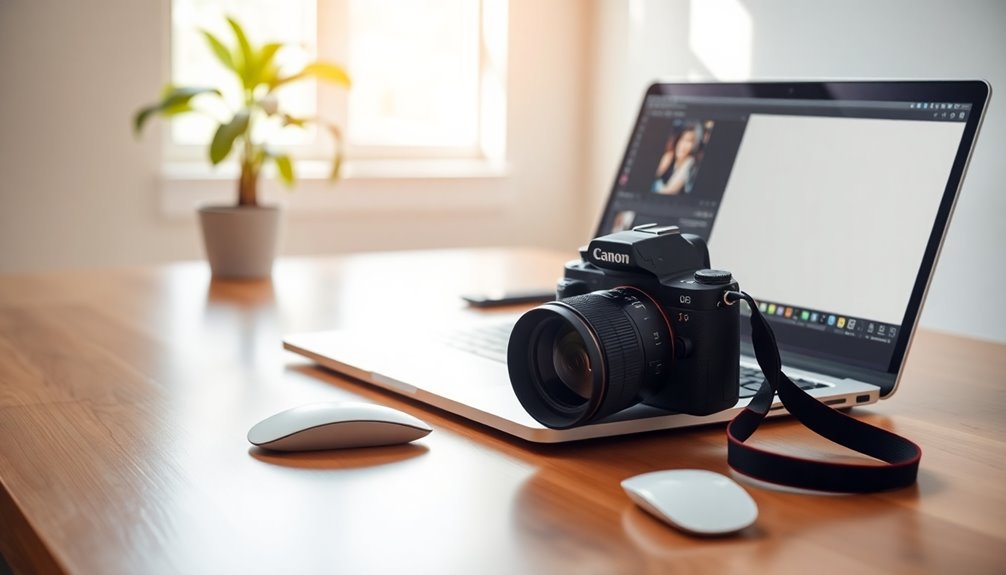
When it comes to minimalist editing, choosing the right software can make all the difference.
You'll want tools that offer essential features like exposure adjustments and cropping options to keep your images clean and focused.
Adobe Lightroom and Photoshop CC are great choices for achieving that perfect minimalist look. Additionally, utilizing software that supports color accuracy can significantly enhance the visual quality of your edited images.
Recommended Software Options
For those diving into minimalist photo editing, choosing the right software can make all the difference in achieving your desired aesthetic.
Adobe Lightroom is a popular choice, thanks to its user-friendly interface and powerful tools for basic adjustments, perfect for enhancing minimalist photography.
If you need advanced editing capabilities, consider Photoshop CC for its detailed layer management and non-destructive editing features.
For stunning black and white conversions, the Nik Collection, especially Silver Efex Pro, excels in focusing on texture and tonal contrast.
Capture One offers professional-grade color grading, ideal for maintaining a cohesive visual style.
Finally, GIMP is a solid free alternative to Photoshop, providing essential features like layers and masks for your minimalist editing needs. Additionally, understanding caffeine content in espresso shots can provide insights into the best times to edit for optimal focus and creativity.
Basic Editing Features Needed
Choosing the right software sets the stage for your minimalist editing journey, but knowing which basic features to utilize is just as important.
For a solid foundation, Lightroom is your go-to for basic exposure and color adjustments, ensuring a clean look. If you want to dive deeper, Photoshop CC offers advanced techniques for precise layer control.
Cropping tools help refine composition, guiding the viewer's eye towards the main subject while eliminating distractions. Additionally, subtle filters can enhance your images without compromising their simplicity. Understanding lighting design can further elevate your photography by creating the desired ambiance in your images.
Key Techniques for a Clean Aesthetic
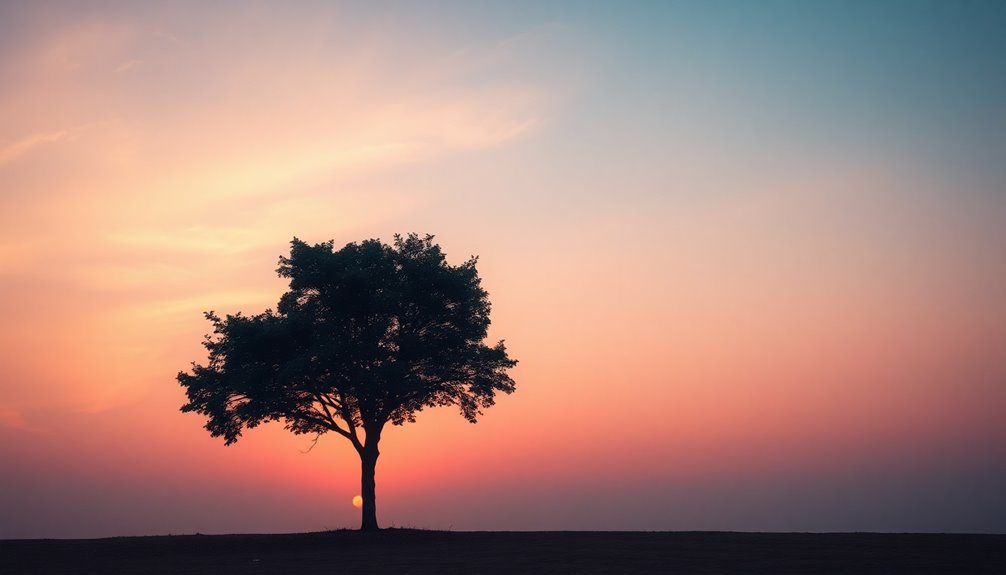
Achieving a clean aesthetic in your photos requires a few key techniques that enhance the overall impact of your images.
First, adjust the exposure to balance lighting, ensuring your subject stands out against a clean background.
Next, utilize negative space effectively to draw attention to your main subject, creating a more impactful composition.
Desaturating colors helps you achieve a muted palette, allowing essential elements to emerge without distraction.
Sharpen details in key areas to emphasize focal points, adding clarity and directing the viewer's gaze.
Finally, apply subtle vignettes to guide attention inward, enhancing the minimalist aesthetic. Incorporating elements from nature, such as herbal tea, can also add a calming touch to your minimalist photography.
The Importance of Color and Texture
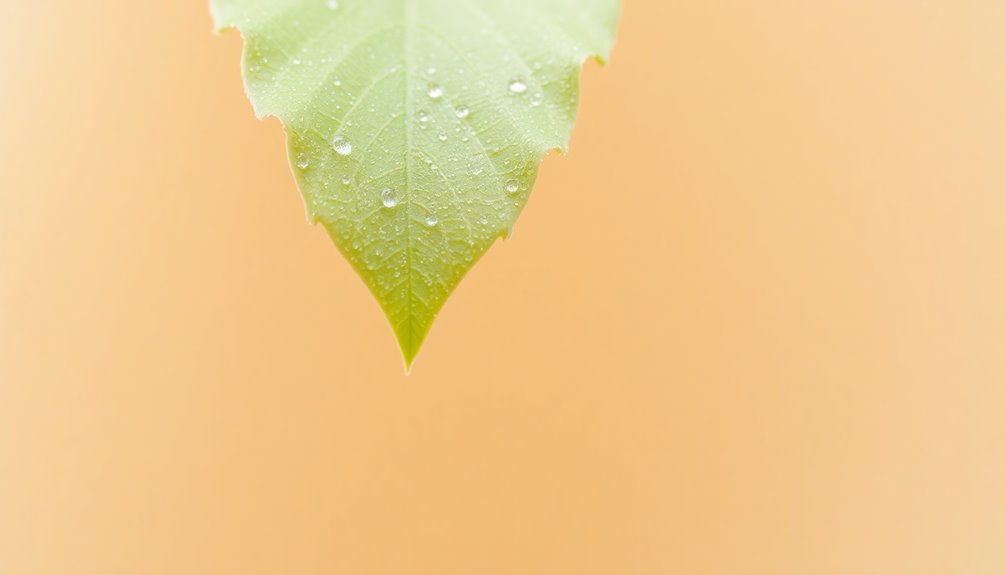
Color and texture are essential elements in minimalist photography, considerably influencing the mood and effectiveness of your images. By thoughtfully incorporating these aspects, you can create compelling visuals that resonate deeply with viewers.
- Soft, muted pastels enhance neutral subjects against simple backgrounds.
- Texture adds depth, making elements like flowers and clouds intriguing.
- A consistent color palette unifies your minimalist series, enhancing cohesion.
- The interplay of color and texture evokes emotions and tells visual stories.
- Patterns in nature, like sunflower fields, emphasize simplicity while enriching your composition.
Focusing on these elements allows you to craft minimalist photographs that not only capture attention but also convey your intended message effectively. Additionally, establishing healthy boundaries in your creative process can help you maintain a clear vision and avoid distractions that may complicate your artistic expression.
Composition Strategies for Minimalism
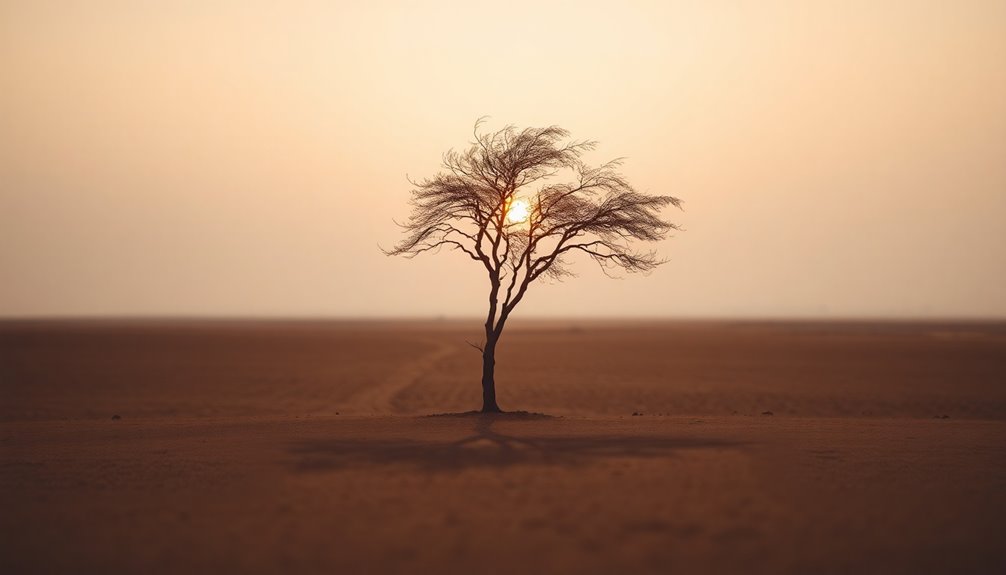
While creating minimalist compositions, it's crucial to understand how strategic placement and simplicity can elevate your photography. Use the rule of thirds to position your main subject effectively, drawing the viewer's eye into the frame.
Incorporate negative space around your subject to maintain a clean aesthetic and enhance the image's impact. Experiment with leading lines to guide the viewer's gaze directly to the focal point, utilizing natural or architectural elements.
Simplify your composition by removing any distractions that don't contribute to the main subject. Finally, consider symmetry and geometric shapes, which can create visually appealing compositions that evoke harmony and order. Additionally, applying empathy-driven design can help you connect better with your audience through your photography.
Each of these strategies can greatly improve your minimalist photography.
Avoiding Common Editing Mistakes
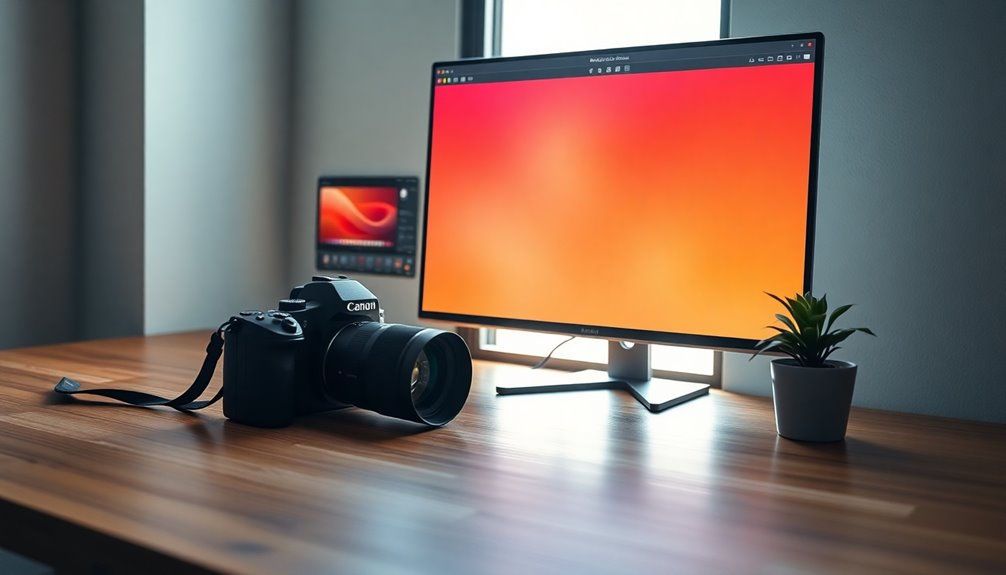
When you're editing, it's easy to go overboard and lose the natural feel of your images. Keep your focus on maintaining clarity and consistency in composition for a cohesive look across your work. Additionally, employing AI-driven analysis can help you identify and correct common editing mistakes before finalizing your images.
Over-editing Dangers
Over-editing can quickly turn a beautiful photograph into an artificial mess, so it's essential to strike the right balance in your editing process.
Here are some common pitfalls to avoid:
- Excessive filters can mask the original beauty of your image.
- Mixing too many editing styles can confuse viewers and dilute your message.
- Cluttered images detract from the minimalist approach—keep it simple.
- Poor color balance can make your photos feel off-putting and unappealing.
- Neglecting negative space can overcrowd your composition, taking attention away from your subject.
Additionally, understanding the importance of emotional growth can help you approach photo editing with a fresh perspective, allowing for a more authentic representation of your artistic vision.
Composition Consistency Importance
Achieving composition consistency is essential for creating a recognizable style in your minimalist photography. When you maintain a uniform approach across your images, your work becomes more impactful and memorable.
Focus on essential elements while avoiding clutter, ensuring each photo conveys a clear message. Regularly assess your images for consistency; this helps you identify deviations and stay true to your artistic vision.
Pay attention to negative space, as it can enhance your overall aesthetic, drawing viewers to your subject. By establishing standards—like the rule of thirds or similar framing techniques—you can prevent common editing mistakes that detract from your minimalist approach. Incorporating ambient lighting techniques can also enhance the mood and clarity of your images.
Consistency not only elevates your portfolio but also strengthens your visual storytelling.
Finalizing Your Minimalist Image
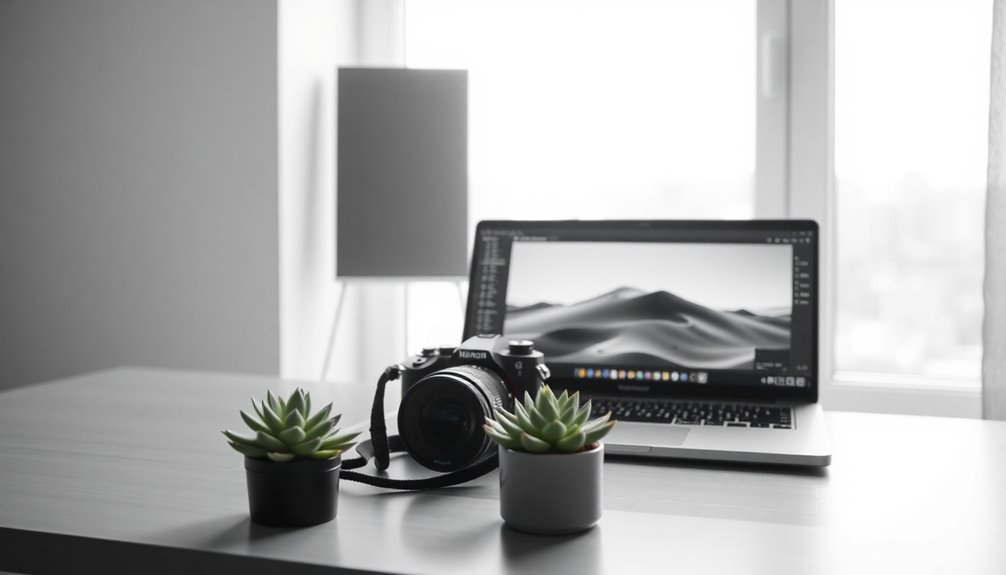
To finalize your minimalist image effectively, start by making essential adjustments in Lightroom or Photoshop. Focus on enhancing your composition with basic tweaks like exposure, contrast, and cropping.
Always keep an eye on the histogram to guarantee balanced tones, avoiding any clipping in highlights or shadows.
Consider these key steps:
- Remove distracting elements to utilize negative space.
- Apply subtle sharpening techniques to enhance your subject's details.
- Save your final image in an 8-bit TIFF or JPEG format.
- Optimize file size for easy sharing or printing.
- Maintain the minimalist aesthetic throughout your editing process.
These steps will help you create a polished, visually striking minimalist image that captures the essence of simplicity.
Equipment Recommendations for Minimalist Photography
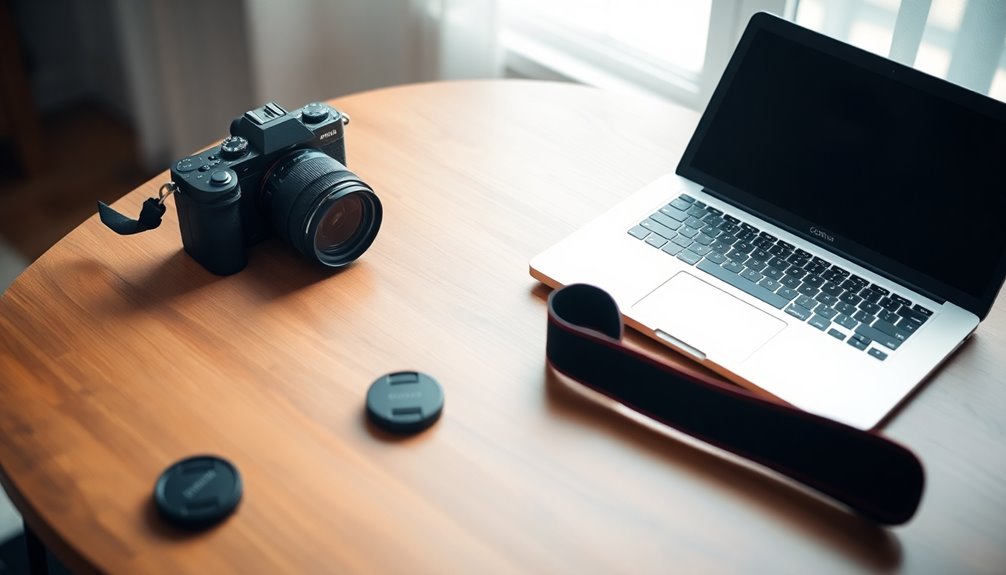
When diving into minimalist photography, having the right gear can make all the difference.
Start with a prime lens, like a 35mm, which offers superior image quality and encourages you to move for better composition instead of zooming. A sturdy tripod is essential for stabilizing your shots, especially in low-light conditions or when using long exposure techniques.
A prime lens and sturdy tripod are vital for achieving sharp compositions and stability in minimalist photography.
Opt for lightweight, compact camera systems to enhance your mobility, allowing you to explore different angles effortlessly. Neutral density filters are great for controlling light intake, enabling longer exposures while keeping a clean aesthetic in bright settings.
Finally, choose a camera with manual settings so you can fine-tune exposure, aperture, and shutter speed, aligning perfectly with minimalist principles.
Finding Inspiration in Minimalist Art
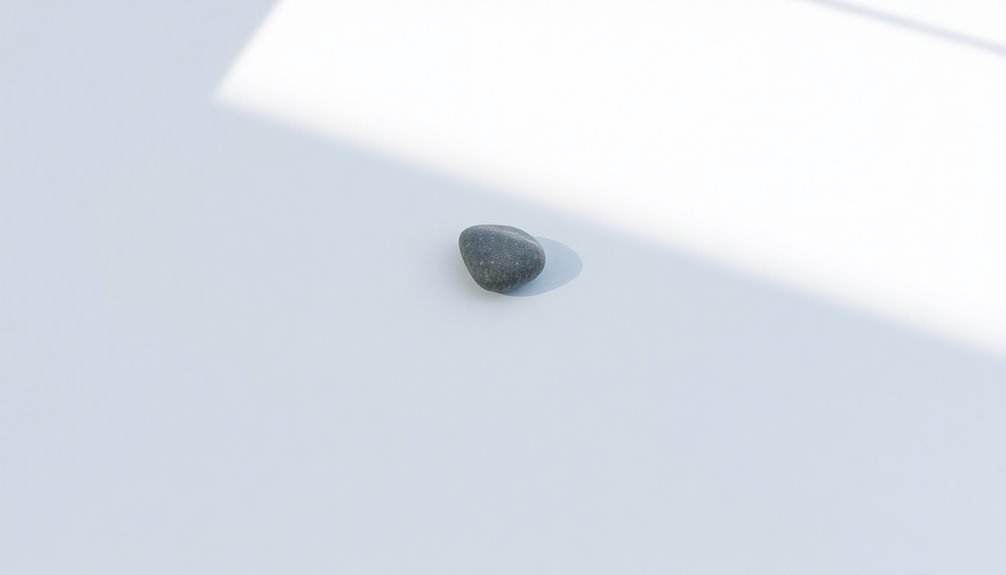
Finding inspiration in minimalist art can transform your approach to photography, as it emphasizes the beauty of simplicity and the power of space.
By exploring this art form, you can refine your compositions and elevate your work. Here's how to draw from minimalist art:
- Focus on geometric shapes to streamline your subjects.
- Embrace negative space to enhance the subject's impact.
- Experiment with subtle color palettes for a cohesive look.
- Study balance and contrast to create harmony in your images.
- Observe the works of artists like Donald Judd and Agnes Martin for fresh perspectives.
Incorporating these elements into your photography can lead to striking images that resonate with viewers, showcasing the profound impact of minimalism.
Frequently Asked Questions
How to Learn Photo Editing for Beginners?
To learn photo editing as a beginner, start by exploring basic software like Lightroom or Photoshop.
Get comfortable with key techniques such as adjusting exposure, cropping, and color correction.
Utilize online tutorials for step-by-step guidance and practice editing a variety of images regularly. This'll help you develop your eye for detail.
Joining photography forums can also provide valuable feedback and insights from others on their editing journeys.
Engage with the community!
What Is the Easiest Photo Editor for Beginners?
Did you know that over 70% of people find photo editing intimidating at first?
If you're looking for the easiest photo editor, Adobe Lightroom's a great choice. Its user-friendly interface and intuitive tools make basic adjustments like exposure and color correction a breeze.
Canva's also fantastic for quick edits with its drag-and-drop functionality.
For mobile, Snapseed offers powerful tools right in your pocket, making it perfect for on-the-go enhancements.
How Do I Make My Photos Look Minimalist?
To make your photos look minimalist, start by simplifying your composition. Remove any distracting elements and focus on your main subject.
Use negative space to create a clean backdrop that draws attention. Adjust exposure and contrast for balanced lighting, highlighting key features.
Desaturate colors for a muted palette, ensuring your subject stands out. Finally, experiment with cropping to keep only essential elements, maintaining that minimalist aesthetic throughout your image.
How Do You Edit Photos so They Look Natural?
To make your photos look natural, start by adjusting exposure, contrast, and white balance in Lightroom.
Crop subtly to enhance composition while keeping the focus on your subject. If colors seem too vibrant, desaturate them for a more organic feel.
Use non-destructive editing techniques in Photoshop to fine-tune without losing the original image quality.
Finally, monitor the histogram to maintain balanced tones, avoiding clipped highlights or shadows.
Conclusion
Embracing minimalist photo editing might seem intimidating at first, but it's all about simplicity and intention. You don't need fancy software or extensive experience—just a few essential tools and a clear vision can transform your images. Remember, less truly is more. By focusing on clean lines, subtle colors, and thoughtful composition, you'll find beauty in simplicity. So go ahead, experiment with your photos, and let minimalism reveal the striking elegance within your shots.
